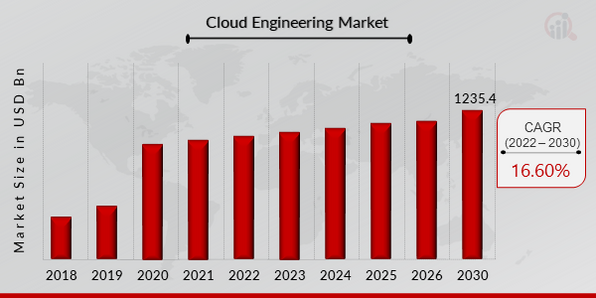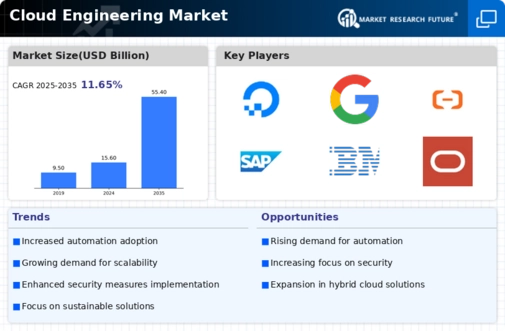Demand for Cloud-Native Applications
The Cloud Engineering Market is increasingly characterized by a growing demand for cloud-native applications. These applications are designed specifically to operate in cloud environments, offering enhanced scalability, resilience, and performance. As businesses strive to innovate and deliver services rapidly, the adoption of cloud-native technologies is becoming paramount. Data indicates that the cloud-native application market is projected to grow at a compound annual growth rate of over 20% in the coming years. This trend is prompting cloud engineering companies to focus on developing frameworks and tools that support the creation and deployment of cloud-native applications, thereby positioning themselves favorably within the Cloud Engineering Market.
Growing Demand for Scalable Solutions
The Cloud Engineering Market is experiencing a notable surge in demand for scalable solutions. Organizations are increasingly seeking cloud services that can easily adapt to their evolving needs. This trend is driven by the necessity for businesses to remain agile in a competitive landscape. According to recent data, the cloud services market is projected to reach a valuation of over 800 billion dollars by 2025, indicating a robust growth trajectory. Companies are recognizing that scalable cloud solutions not only enhance operational efficiency but also reduce costs associated with infrastructure management. As a result, cloud engineering firms are innovating to provide flexible architectures that can accommodate varying workloads, thereby solidifying their position in the Cloud Engineering Market.
Integration of Multi-Cloud Strategies
The Cloud Engineering Market is witnessing a shift towards multi-cloud strategies, where organizations utilize services from multiple cloud providers. This approach allows businesses to avoid vendor lock-in and optimize their cloud environments for performance and cost. Recent surveys indicate that over 80% of enterprises are adopting multi-cloud strategies, reflecting a significant trend in the market. By leveraging the strengths of various cloud platforms, organizations can enhance their operational resilience and flexibility. Cloud engineering firms are thus focusing on developing solutions that facilitate seamless integration and management of multi-cloud environments, which is likely to drive further growth in the Cloud Engineering Market.
Enhanced Security and Compliance Requirements
In the Cloud Engineering Market, the emphasis on security and compliance has intensified. Organizations are increasingly aware of the risks associated with data breaches and regulatory non-compliance. As a response, cloud service providers are investing heavily in advanced security measures and compliance frameworks. Recent statistics suggest that The Cloud Engineering Market is expected to grow significantly, potentially exceeding 50 billion dollars by 2026. This growth is indicative of the rising demand for secure cloud environments. Consequently, cloud engineering solutions that prioritize security features, such as encryption and identity management, are becoming essential for businesses aiming to protect sensitive information while leveraging cloud technologies.
Focus on Cost Efficiency and Resource Optimization
Cost efficiency remains a critical driver in the Cloud Engineering Market. Organizations are increasingly seeking ways to optimize their cloud expenditures while maximizing resource utilization. The shift towards pay-as-you-go pricing models has made it easier for businesses to manage costs effectively. Recent analyses suggest that companies can save up to 30% on IT budgets by migrating to cloud solutions. This financial incentive is prompting more organizations to explore cloud engineering services that emphasize resource optimization and cost management. As a result, cloud engineering firms are innovating to provide tools and strategies that help clients achieve greater cost efficiency, thereby enhancing their competitive edge in the Cloud Engineering Market.


















Leave a Comment